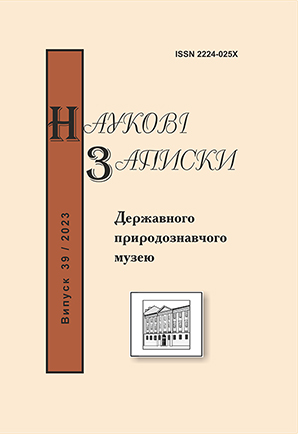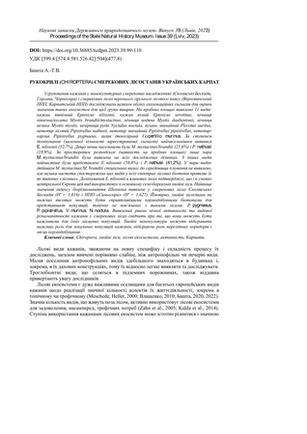Bashta A.-T.
Bats (Chiroptera) of spruce forests in the Ukrainian Carpathians // Proc. of the State Nat. Hist. Mus. - Lviv, 2023. - 39. - P. 99-110 DOI: https://doi.org/10.36885/nzdpm.2023.39.99-110 Key words: Chiroptera, coniferous forests, forest ecosystems, activity, Carpathians Bat communities in monoculture spruce plantations (Skolivski Beskydy NNP, Gorgany (NNP Syniohora) and Chornohora areas) and spruce forests of the upper mountain forest belt (Verkhovynskyi NNP, Karpatskyi NNP) were studied by recording echolocation calls to assess the importance of such ecosystems for this group of animals. 11 species were recorded at the sample plots: Northern bat Eptesicus nilssonii, Serotine bat Eptesicus serotinus, Brand’s bat/Whiskered bat Myotis brandtii/mystacinus, Daubenton’s bat Myotis daubentonii, Greater mouse-eared bat Myotis myotis, Common noctule Nyctalus noctula, Brown long-eared bat Plecotus auritus, Nathusius’s bat Pipistrellus nathusii, Common pipistrelle Pipistrellus pipistrellus, Soprano pipistrelle Pipistrellus pygmaeus, Parti-coloured bat Vespertilio murinus. According to the degree of dominance (total number of registered calls), E. nilssonii was the most numerous (32.7%). M. mystacinus/brandtii (25.6%) and P. nathusii (18.9%) were somewhat less numerous. According to the spatial distribution (presence in the sample plots), only the pair M. mystacinus/brandtii was detected in all the studied plots. Of the other species, E. nilssonii (58.8%) and P. nathusii (41.2%) were most frequently represented. For the sibling species M. mystacinus/M. brandtii no special habitat requirements were found, but the high frequency of their observations in all ranges of forest biotopes shows them as typical "forest". The dominance of E. nilssonii in spruce forests confirms that this species mainly uses semi-boreal coniferous forests in the Central Europe. The highest value of Shannon's biodiversity index was found in spruce forests of lower altitudes, Skolivski Beskydy NNP (H' = 1.616) and Syniohora NNP (H' = 1.627). Probably, coniferous forests at lower altitudes can be more favourable foraging biotopes for representatives of populations that are not topically associated with such forests: P. pygmaeus, P. pipistrellus, V. murinus, N. noctula. The observed level of nocturnal activity and species diversity of bats in spruce forests suggests that they may be important to their local populations. Coniferous monocultures can play an important role for local bat populations by acting as migratory corridors and foraging sites.
Bats (Chiroptera) of spruce forests in the Ukrainian Carpathians // Proc. of the State Nat. Hist. Mus. - Lviv, 2023. - 39. - P. 99-110 DOI: https://doi.org/10.36885/nzdpm.2023.39.99-110 Key words: Chiroptera, coniferous forests, forest ecosystems, activity, Carpathians Bat communities in monoculture spruce plantations (Skolivski Beskydy NNP, Gorgany (NNP Syniohora) and Chornohora areas) and spruce forests of the upper mountain forest belt (Verkhovynskyi NNP, Karpatskyi NNP) were studied by recording echolocation calls to assess the importance of such ecosystems for this group of animals. 11 species were recorded at the sample plots: Northern bat Eptesicus nilssonii, Serotine bat Eptesicus serotinus, Brand’s bat/Whiskered bat Myotis brandtii/mystacinus, Daubenton’s bat Myotis daubentonii, Greater mouse-eared bat Myotis myotis, Common noctule Nyctalus noctula, Brown long-eared bat Plecotus auritus, Nathusius’s bat Pipistrellus nathusii, Common pipistrelle Pipistrellus pipistrellus, Soprano pipistrelle Pipistrellus pygmaeus, Parti-coloured bat Vespertilio murinus. According to the degree of dominance (total number of registered calls), E. nilssonii was the most numerous (32.7%). M. mystacinus/brandtii (25.6%) and P. nathusii (18.9%) were somewhat less numerous. According to the spatial distribution (presence in the sample plots), only the pair M. mystacinus/brandtii was detected in all the studied plots. Of the other species, E. nilssonii (58.8%) and P. nathusii (41.2%) were most frequently represented. For the sibling species M. mystacinus/M. brandtii no special habitat requirements were found, but the high frequency of their observations in all ranges of forest biotopes shows them as typical "forest". The dominance of E. nilssonii in spruce forests confirms that this species mainly uses semi-boreal coniferous forests in the Central Europe. The highest value of Shannon's biodiversity index was found in spruce forests of lower altitudes, Skolivski Beskydy NNP (H' = 1.616) and Syniohora NNP (H' = 1.627). Probably, coniferous forests at lower altitudes can be more favourable foraging biotopes for representatives of populations that are not topically associated with such forests: P. pygmaeus, P. pipistrellus, V. murinus, N. noctula. The observed level of nocturnal activity and species diversity of bats in spruce forests suggests that they may be important to their local populations. Coniferous monocultures can play an important role for local bat populations by acting as migratory corridors and foraging sites.
References
- Башта А.-Т.В. 2020. Кажани наших лісів. Науково-популярне видання. Львів : ЗУКЦ. 120 с.
- Башта А.-Т.В. 2022. Кажани Сhiroptera в лісових екосистемах: ключові фактори для збереження популяцій. Науковий вісник НЛТУ України. Т.32 № 1. С. 62–67. DOI: https://doi.org/10.36930/40320109
- Башта А.-Т.В., Приндак В.П. 2017. Рукокрилі (Chiroptera) в умовно-корінних букових і похідних смерекових лісах Сколівських Бескидів (Українські Карпати): видовий склад, добова активність і структура угруповань. Наукові основи збереження біотичної різноманітності. Т. 8(15) № 1. С. 113–124.
- Влащенко А.С. 2010. Вплив лісогосподарської діяльності на кажанів та їх охорона в лісах України (на прикладі Національного природного парку «Гомільшанські ліси»). Заповідна справа в Україні. Т. 16 Вип. 1. С. 44–50.
- Волошин Б., Башта А.-Т. 2001. Кажани Карпат. Польовий визначник. Кракiв-Львiв : Platan Publ. House. 168 c.
- Голубец М.А. 1978. Ельники Украинских Карпат. К. : Наук. думка. 252 с.
- Aldridge H.D.J.N., Rautenbach I.L. 1987. Morphology, Echolocation and Resource Partitioning in Insectivorous Bats. J. Anim. Ecol. V. 56. P. 763–778. DOI: https://doi.org/10.2307/4947
- Apoznański G., Kokurewicz T., Błesznowska J. Kwasiborska E., Marszałek T., Górska M. 2020. Use of coniferous plantations by bats in western Poland during summer months. Baltic Forestry. V. 26 (2). P. 185–192. DOI: https://doi.org/10.46490/BF232
- Arlettaz R. 1999. Habitat selection as a major resource partitioning mechanism between the two sympatric sibling bat species Myotis myotis and Myotis blythii. J. Anim. Ecol. V. 68. P. 460–471. DOI: https://doi.org/10.1046/j.1365-2656.1999.00293.x
- Barataud M. 2020. Acoustic Ecology of European Bats. Species Identification, Study of their Habitats and Foraging Behaviour. 2nd edition. Paris : Muséum national d'Histoire naturelle. 368 p.
- Barlow K.E. 1997. The diets of two phonic types of the bat Pipistrellus pipistrellus in Britain. J. Zool. (Lond.) V. 243. P. 597–609. DOI: http://dx.doi.org/10.1111/j.1469-7998.1997.tb02804.x.
- Bender M.J., Castleberry S.B., Miller D.A., Bently Wigley T. 2015. Site occupancy of foraging bats on landscapes of managed pine forest. Forest Ecology and Management. V. 336. P. 1–10. DOI: 10.1016/j.foreco.2014.10.004
- Brigham R.M., Grindal S.D., Firman M.C., Morrisette J.L. 1997. The influence of structural clutter on activity patterns of insectivorous bats. Can. J. Zool. V. 75. P. 131–136.
- Boughey K.L., Lake I.R., Haysom K.A., Dolman P.M. 2011. Effects of landscape-scale broadleaved woodland configuration and extent on roost location for six bat species across the UK. Biological Conservation. V. 144. P. 2300–2310. DOI: https://doi:10.1016/j.biocon.2011.06.008
- Charbonnier Y., Barbaro L., Theillout A., Jactel H. 2014. Numerical and functional responses of forest bats to a major insect pest in pine plantations. PLoS ONE. V. 10 (1). e0117652. DOI: https://doi.org/10.1371/journ al.pone.0109488
- Charbonnier Y., Gauzere P., van Halder I., Nezan J., Barnagaud J.-Y., Jactel H., Barbaro L. 2016. Deciduous trees increase bat diversity at stand and landscape scales in mosaic pine plantations. Landscape Ecology. V. 31. P. 291–300.
- Dietz C., von Helversen O. 2004. Illustrated identification key to the bats of Europe. Electronic publication. Version 1.0. Tuebingen. 72 pp. Доступне: http://www.uni-tuebingen.de/tierphys/ Kontakt/ mitarbeiter_seiten/dietz.htm [Accessed 15 December 2004]
- Gardner T.A. 2012. Monitoring Forest Biodiversity: Improving Conservation through ecologically Responsible Management. London : Earthscan. 388 p.
- Hammer M., Zahn A. 2009. Kriterien für die Wertung von Artnachweisen basierend auf Lautaufnahmen. Patersdorf Koordinationsstellen für Fledermausschutz. Version 1. 89 s.
- Kalda R., Kalda O., Lohmus K., Liira J. 2014. Multi-scale ecology o woodland bat the role of species pool, landscape complexity and stand structure. Biodivers. Conserv. V. 24. P. 337–353. DOI: 10.1007/s10531-014-0811-6
- Kirkpatrick L., Maher S.J., Lopez Z., Lintott P.R., Bailey S.A., Dent D., Park K.J. 2017. Bat use of commercial coniferous plantations at multiple spatial scales: Management and conservation implications. Biological Conservation. V. 206. P. 1–10. DOI: 10.1016/j.biocon.2016.11.018
- Limpens H.J.G.A., Kapteyn K. 1991. Bats, their behaviour and linear landscape elements. Myotis. V. 29. P. 63–71.
- Meschede A., Heller K.-G. 2000. Ökologie und Schutz von Fledermäusen in Wäldern. Schriftenreihe fur Landschaftspflege und Naturschutz 66. Bonn-Bad Godesberg : Bundesamt fur Naturschutz. 374 s.
- Morris A.D., Miller D.A., Kalcounis-Rüppell M.C. 2010. Use of forest edges by bats in a managed pine forest landscape. J. Wildl. Manag. V. 74. P. 26–34. DOI: https://doi.org/10.2193/2008-471
- Nicholls B., Racey P. 2006. Habitat selection as a mechanism of resource partitioning in two cryptic bat species Pipistrellus pipistrellus and Pipistrellus pygmaeus. Ecography. V. 29. P. 97–708. DOI: http://dx.doi.org/10.1111/j.2006.0906-7590.04575.x
- Nissen H., Krüger F., Fichtner A., Sommer R. 2013. Local variability in the diet of Daubenton's bat (Myotis daubentonii) in a lake landscape of northern Germany. Folia Zoologica. V. 61 (2). P. 36–41. DOI: 10.25225/fozo.v62.i1.a5.2013
- Patriquin K.J., Barclay R.M.R. 2003. Foraging by bats in cleared, thinned and unharvested boreal forest. Journal of Applied Ecology. V. 40. P. 646–657. DOI: https://doi.org/10.1046/ j.1365-2664.2003.00831.x
- Pereira M.J., Peste F., Paula A., Pereira P., Bernardino J., Vieira J., Bastos C., Mascarenhas M., Costa H., Fonseca C. 2016. Managing coniferous production forests towards bat conservation. Wildlife Research. V. 43 (1). P. 80–92. DOI: https://doi.org/10.1071/WR14256
- Russ J. 2021. Bat Calls of Britain and Europe: A Guide to Species Identification. Exeter : Pelagic Publishing. 462 p.
- Russo D., Jones G. 2003. Use of foraging habitats by bats in a Mediterranean area determined by acoustic surveys: conservation implications. Ecography. V. 26. P. 197–209. DOI: 10.1034/j.1600-0587.2003.03422.x
- Russo D., Billington G., Bontadina F., Dekker J., Dietz M., Jones G., Meschede A., Rebelo H., Reiter G. 2016. Identifying key research objectives to make European forests greener for bats. Frontiers in Ecology and Evolution. V. 4. P. 1–8. DOI: https://doi.org/10.3389/fevo.2016.00087
- Russo D., Cistrone L., Garonna A.P., Jones G. 2010. Reconsidering the importance of harvested forests for the conservation of tree-dwelling bats. Biodivers. Conserv. V. 19. P. 2501–2515. DOI: 10.1007/s10531-010-9856-3
- Sachanowicz K., Ciechanowski M., Piksa K. 2006. Distribution patterns, species richness and status of bats in Poland. Vespertilio. V. 9–10. P. 151–173.
- Skiba R. 2003. Europäische Fledermäuse; Kennzeichen, Echoortung und Detektoranwendung. Hohenwarsleben : Westarp. 212 s. Thomas D.W. 1988. The distribution of bats in different ages of douglas-fir forests. J. Wildl. Manag. V. 52. P. 619–626. DOI: https://doi.org/10.2307/3800920
- Tibbels A.E., Kurta A. 2003. Bat activity is low in thinned and unthinned stands of red pine. Can. J. For. Res. V. 33. P. 2436–2442. DOI: https://doi.org/10.1139/x03-177
- Verboom B., Spoelstra K. 1999. Effects of food abundance and wind on the use of tree lines by an insectivorous bat, Pipistrellus pipistrellus. Can. J. Zool. V. 77. P. 1393–1401. DOI: http://dx.doi.org/10.1139/cjz-77-9-1393
- Walsh A.L., Harris S. 1996. Habitat Preferences of Vespertilionid Bats in Britain. Journal of Applied Ecology. V. 33. P. 508–518. DOI: https://doi.org/10.2307/2404980
- Węgiel A., Grzywiński W., Ciechanowski M., Jaros R., Kalcounis Rüppell M., Kmiecik A., Kmiecik P., Węgiel J. 2019. The foraging activity of bats in managed pine forests of diferent ages. European Journal of Forest Research. V. 138. P. 383–396. DOI: https://doi.org/10.1007/s10342-019-01174-6
- Zahn A., Haselbach H., Guttinger R. 2005. Foraging activity of central European Myotis myotis in a landscape dominated by spruce monocultures. Mammal. Biol. V. 70. P. 265–270. DOI: 10.1016/j.mambio.2004.11.020


